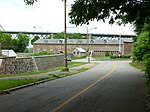Jacques Cartier Bridge

The Jacques Cartier Bridge (French: pont Jacques-Cartier) is a steel truss cantilever bridge crossing the Saint Lawrence River from Montreal Island, Montreal, Quebec, to the south shore at Longueuil, Quebec, Canada. The bridge crosses Saint Helen's Island in the centre of the river, where offramps allow access to the Parc Jean-Drapeau and La Ronde amusement park. Originally named the Montreal Harbour Bridge (pont du Havre), it was renamed in 1934 to commemorate the 400th anniversary of Jacques Cartier's first voyage up the St. Lawrence River. The five-lane highway bridge is 3,425.6 m (11,239 ft) in length, including the approach viaducts. There are approximately 35.8 million vehicle crossings annually, making it the third busiest bridge in Canada, the first being Samuel-de-Champlain Bridge, just a few kilometres (miles) upstream. The second busiest bridge in Canada overall is the Port Mann Bridge in Metro Vancouver (connecting Surrey to Coquitlam). Together with the Champlain Bridge, it is administered by the Jacques Cartier and Champlain Bridges Incorporated (JCCBI), a Canadian Crown Corporation which reports to Infrastructure Canada.
Excerpt from the Wikipedia article Jacques Cartier Bridge (License: CC BY-SA 3.0, Authors, Images).Jacques Cartier Bridge
Pont Jacques-Cartier, Montreal Ville-Marie
Geographical coordinates (GPS) Address Nearby Places Show on map
Geographical coordinates (GPS)
| Latitude | Longitude |
|---|---|
| N 45.520833333333 ° | E -73.535 ° |
Address
Pont Jacques-Cartier
Pont Jacques-Cartier
J4K 1A7 Montreal, Ville-Marie
Quebec, Canada
Open on Google Maps









